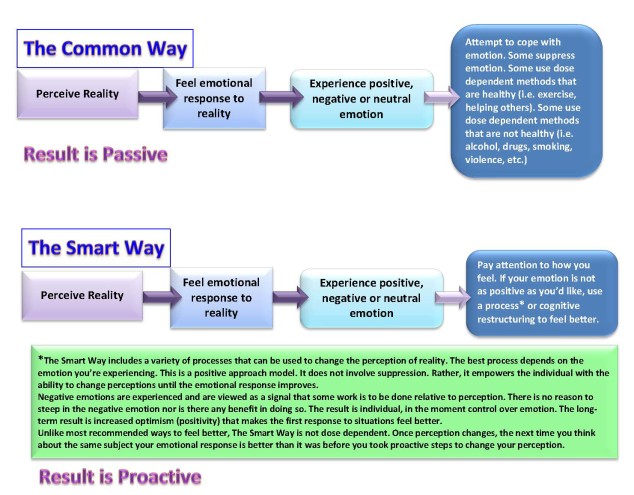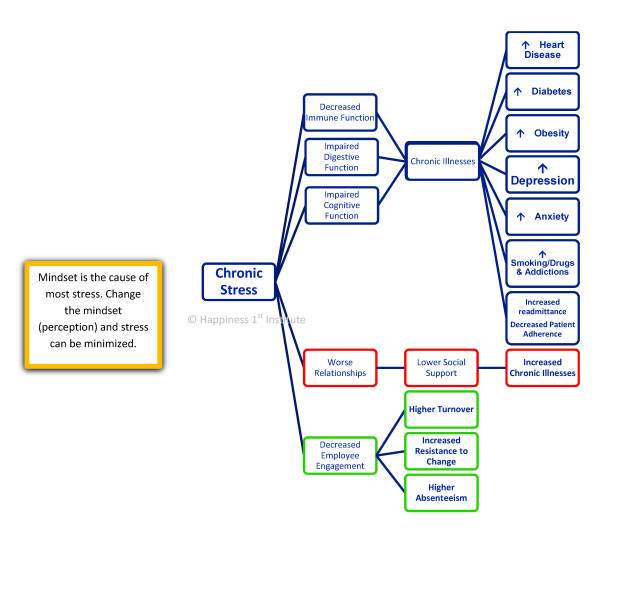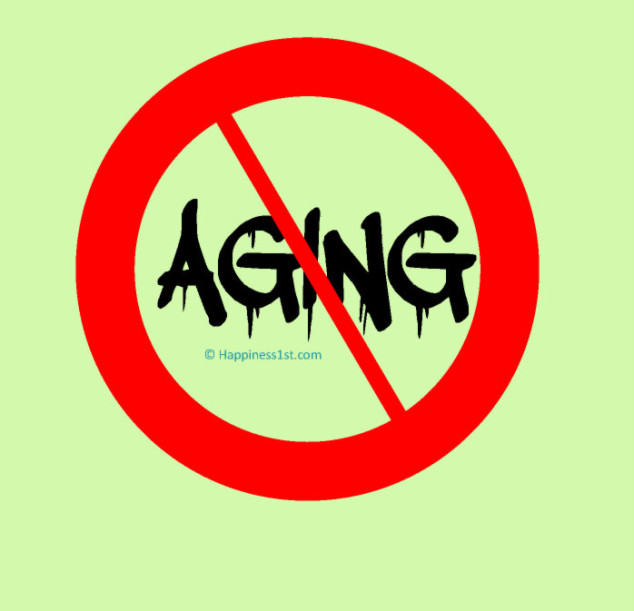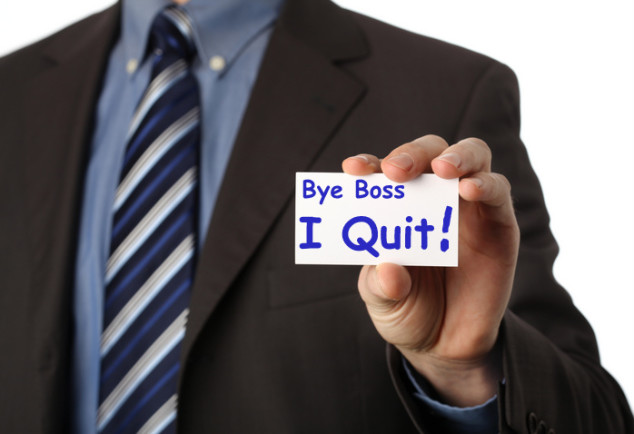Author Archive: JeanineJoy
The Smart Way: What is it?
People frequently ask me, “What do you mean by The Smart Way?” Today, while reading some research on happiness by Sonja Lyubomirsky, Laura King, and one of my favorite Psychologists, Ed Diener the way they described their research helped me create the briefest explanation ever of the difference between The Smart Way and The Common Way.
Most of the world lives their lives using The Common Way. It’s not because they lack intelligence. It’s simply a lack of knowledge. It’s what they don’t know they don’t know.
The diagram below shows the difference. The Common Way is passive. Life happens to you. When you apply The Smart Way, it begins feeling like you have some control over how you experience life. It’s a more empowered way of viewing your reality and experiencing your life. A life lived using The Smart Way feels better than a life lived The Common Way. The results of your efforts are better when you use The Smart Way.
The Smart Way is at the root cause of human thriving. Because it is at the root, every improvement affects many branches (areas of life).
I’m pragmatic. I like things simple. I like things that work. I don’t like reinventing the  wheel if I already have a solution that works. I love helping people thrive more. I love sharing the knowledge I’ve found in my search for answers to the question, “What empowers humans to thrive?” I don’t want to just help some people. I want to help everyone I can possibly help. The Smart Way works. It increases the frequency of positive emotions an individual feels.
wheel if I already have a solution that works. I love helping people thrive more. I love sharing the knowledge I’ve found in my search for answers to the question, “What empowers humans to thrive?” I don’t want to just help some people. I want to help everyone I can possibly help. The Smart Way works. It increases the frequency of positive emotions an individual feels.
What good is feeling good?
Turns out feeling good does a lot of good. It improves your physical, mental, emotional, and behavioral results. It is less stressful and stress is at the root of most illnesses and diseases. Happy people aren’t committing crimes. In fact, people commit crimes because they are so stressed about their situation that the only way they can perceive of feeling better is through the commission of a crime. Only happy people can feel at peace with others.
Once I identified the root cause of human thriving, I began building bridges that would help people understand and, more importantly, use the knowledge to make their own lives better. I created bridges that helped individuals who were religious to understand how The Smart Way fit with their worldview. I created bridges that helped individuals who want a scientific basis to understand the science that supports The Smart Way.
In The Smart Way books, all the basic elements of The Smart Way are included, plus information relative to the subject of the book. As I find more supporting research, I add it to the newer titles. I change examples based on the subject of the book. But if you have one, The Smart Way book, you have all the key elements of any book in the series. I don’t reinvent the wheel for each subject because the root of thriving in all of them is the same.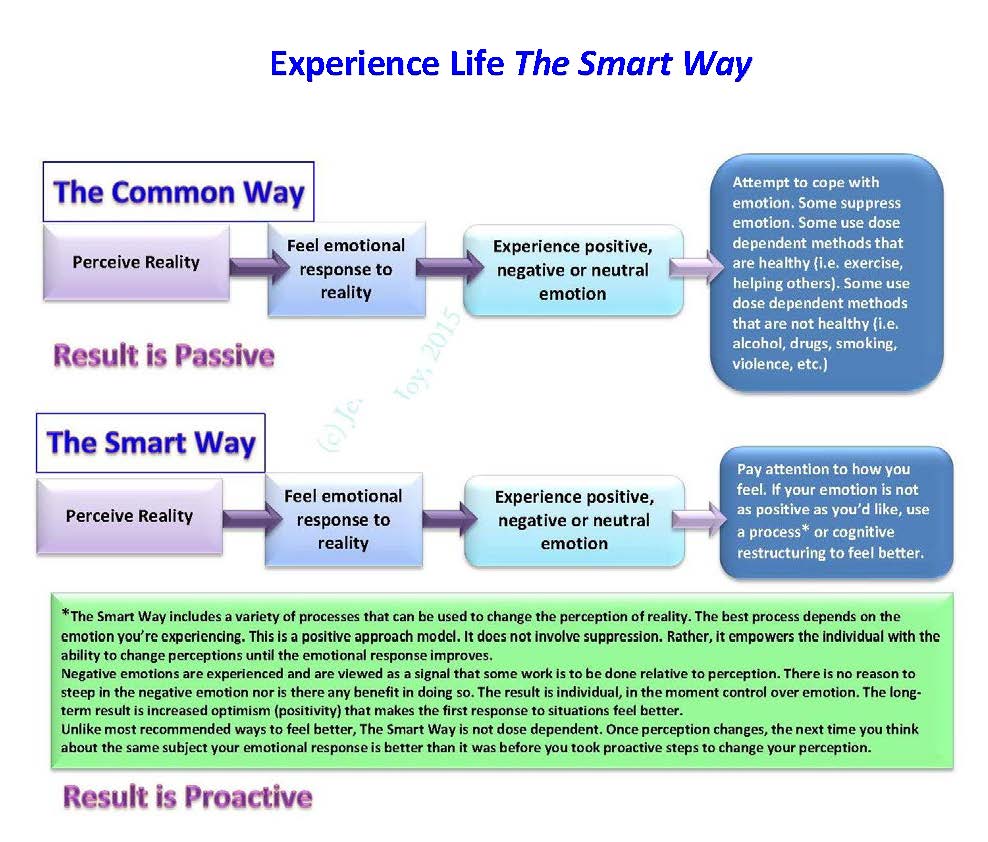
Today only one The Smart Way book is published, but four more are in the pipeline. So remember, if you have one The Smart Way book you don’t have to buy others. It might be easier to figure out how to apply it to the subject of the book and if you want it to help with that, it’s worthwhile. But if you have one and you’re not thriving more you read the book instead of studying it and using the techniques. Try them. You’ll like it.
Prevent Suicide: The Smart Way is available. New books about building resilience, reducing crime, improving health, and improving relationships are in the works.
Robin Williams: Reflections a Year Later
One year ago my “to do” list for this week included “Finish editing suicide prevention book.”
Then I logged on to the internet and learned that Robin Williams had died by suicide.
I felt a lot of different emotions that day. I remember wondering if I had written the book sooner if I could have made a difference. I was very certain that I did not want to appear to be capitalizing on Robin Williams death. I was saddened by the loss, knowing that his was a rare and beautiful talent that brought so much that was good to our world. I worried about my daughter who was in another state visiting a friend because she had to be one of his biggest fans. I worried about the contagion effect, how someone who was suicidal might think that if Robin Williams could not make his life feel better than how could they expect to do so.
I remembered times in my life when I was suicidal and did not act on those feelings and felt grateful. I remembered those who had been suicidal whom I had helped feel better and felt more gratitude for the knowledge I had gained that allowed me to be of benefit and for being in the right place at the right time.
I put the book aside for a while. I thought the world was too raw to receive it as it was and perhaps I was also too disheartened not to have been in the right place at the right time for Robin Williams. I’ve always had an overactive sense of responsibility for others. This was no exception.
I had a month across the pond planned and I decided to finish editing the book after that trip. The week before I left I had lunch with a friend who knew nothing about the book I was writing. During lunch, she shared with me that a close friend of hers was suffering because her boyfriend had ended his life. I took that to be a sign that I needed to get the book finished. I was too late to help Robin Williams, but there were hundreds of thousands of others who were still suffering and thousands of them would make a fatal mistake each year.
When I returned from my time overseas, I finished the book and it was published last Autumn. I’ve still been hesitant about being perceived as attempting to capitalize on Robin Williams’ death so I worked hard to put the book on Smashwords in an electronic version–something that had a steep learning curve for me. I did not really like the electronic format because citations and other helpful information did not translate well into the electronic format. I’m still not satisfied with the version on Smashwords, but it contains the essence of the helpful information. I frequently give electronic copies away. The current coupon code for Smashwords is JW78C. The print version is better, in my opinion. The print version is available here.
The focus of Prevent Suicide: The Smart Way is to prevent suicide through the use of Primary Prevention. Hand washing is an example of primary prevention of disease. Primary Prevention is something done that is truly preventative–not just early detection. Via early prevention, the undesired outcome is actually prevented. Hand washing prevents the spread of illnesses. Primary Prevention for suicide prevents the sustained low emotional states that can lead to suicidal ideation and suicide and also builds strengths. It is not just for those who are already in low emtional states, although it is beneficial to them. The time to use primary prevention is before there is a problem so the problem won’t develop. Every adult and child can benefit from this form of primary prevention.
I wish everyone a wonderful life. If my work helps you live a better life, it fills my heart with appreciation of where my life had led me and the knowledge I’ve gained along the way.
Be Well,
Jeanine Joy
If you are thinking that maybe you’d rather be dead or that those you care about would be better off if you were, call the toll-free, 24-hour hotline of the National Suicide Prevention Lifeline now at 1-800-273-TALK (1-800-273-8255); TTY: 1-800-799-4TTY (4889) to talk to a trained counselor. Or, call your doctor, dial 911, or go to an emergency room. For a free detailed booklet on depression and its treatment, go to: http://www.nimh.nih.gov/health/publications/depression/complete-index.shtml
International Emergency Numbers
Another Opinion: Retirement Adjustments
In my Another Opinion posts, I answer questions that were asked of syndicated advice columns–providing another opinion.
In the July 30, 2015, Charlotte Observer a recent retiree asked Amy Dickinson how to respond to the question, “What do you do all day?” The retiree stated he was feeling put down for no longer working full time and signed his letter – Retired and Happy
Amy’s advice was fine, as far as it went, “Use it to begin a conversation that might be interesting.” (paraphrased)
Going deeper with the answer would be of more benefit to Retired and Happy.
Humans use labels to describe ourselves. Many labels are attached to us even before we’re born (i.e. our age, racial heritage, socioeconomic class, etc.) Others labels are attached to us as soon as we’re born (gender, healthy, unhealthy, fussy, good, etc.). This pattern continues throughout life. We then internalize those labels and use them to define who we are. Our self-esteem is often tied to the labels we accept as self-defining. Life is a series of stages that we pass through. We define ourselves by the labels attached to us at specific stages (student, adult, single, married, divorced, doctor, graduate, lawyer, businessman, athlete, parent, retiree, etc.)
When we transition from one stage (label) to another it is important that we stop judging our worth based on a label we have outgrown.
- The former student who continues to judge herself by always being right becomes afraid to take risks she should take because she is still attempting to get straight A’s. As a businesswoman, she has to learn to take risks if she wants to succeed.
- The newly married individual can experience significant adjustments such as making sure the plans he makes don’t conflict with his wife’s plans.
- The college football linebacker has to adjust his diet when he gets a desk job because he is no longer burning as many calories.
- The working woman decides to stay home to raise her children has to adjust her perception of self or she will be frustrated at the lack of intellectual stimulation and adult interaction she receives, which can result in her seeming needy to her spouse who is still going to an outside job each day.
- The wife whose stay-at-home husband returns to the workforce after the children go to college must adjust her expectations about the chores he will continue doing at home, or he will feel overburdened.
- The recently disabled individual must adjust the basis of his self-worth if it was tied to his physical prowess or face extra and unnecessary problems with plummeting self-esteem on top of dealing with the physical challenges.
The recent retiree who feels a bit defensive when people ask him what he does all day is reflecting that he feels less valuable now that he is no longer going to working. Seniors have significant value that is unique to them–the wisdom each of us gains from life experiences. He is simply using old criteria to judge the worth of his current activities. A simple adjustment in the basis for his self-worth will enable him to see the question about how he spends his days as the innocent conversation it is and not a condemnation of his choice to retire. It may take a little work to adjust the basis because many of us are taught that we are only valuable when we are contributing through work, but a change of perception is possible and will make life better for him.
Until he makes this shift, he will have difficulty taking this common question into stride, despite his great answer, “Whatever I want.” He’ll enjoy his ability to do whatever he wants far more when he’s not fighting a sense that his value as a human being is less because he is retired. It’s not.
Another Opinion
Periodically I am going to post Another Opinion to questions asked of Amy Dickinson and Billy Graham. I’ve always loved reading advice columns and find that questions draw from me answers I was not aware I had until I hear the question.
Often I believe that the answers individuals are provided in the advice columns fall short. I also have an advantage. I am not limited to thde space constraints these syndicated columnists have although sometimes I may attempt to answer with as much brevity as they use. However, when larger examples are helpful I don’t know why newspapers don’t include a link to a deeper dive into the answer. Doing so could be a real public service.
The first one is titled, “Woman wants trip with mom” and indicates she is looking forward to a road trip with her mom to visit her brother. The problem is her Uncle who talks non-stop has invited himself to join them and neither of them want him to join them for the trip because they want one-on-one time together.
Where the brother they are visiting resides he would be most welcome. This accomplishes their goal of getting one-on-one time but does not make the uncle feel unappreciated or unloved.
It’s just another opinion. We all have one. This is mine. Today. Tomorrow it could be different.
This column was originally published July 17, 2015 in the Charlotte Observer.
Stressed Employees and Business Owners
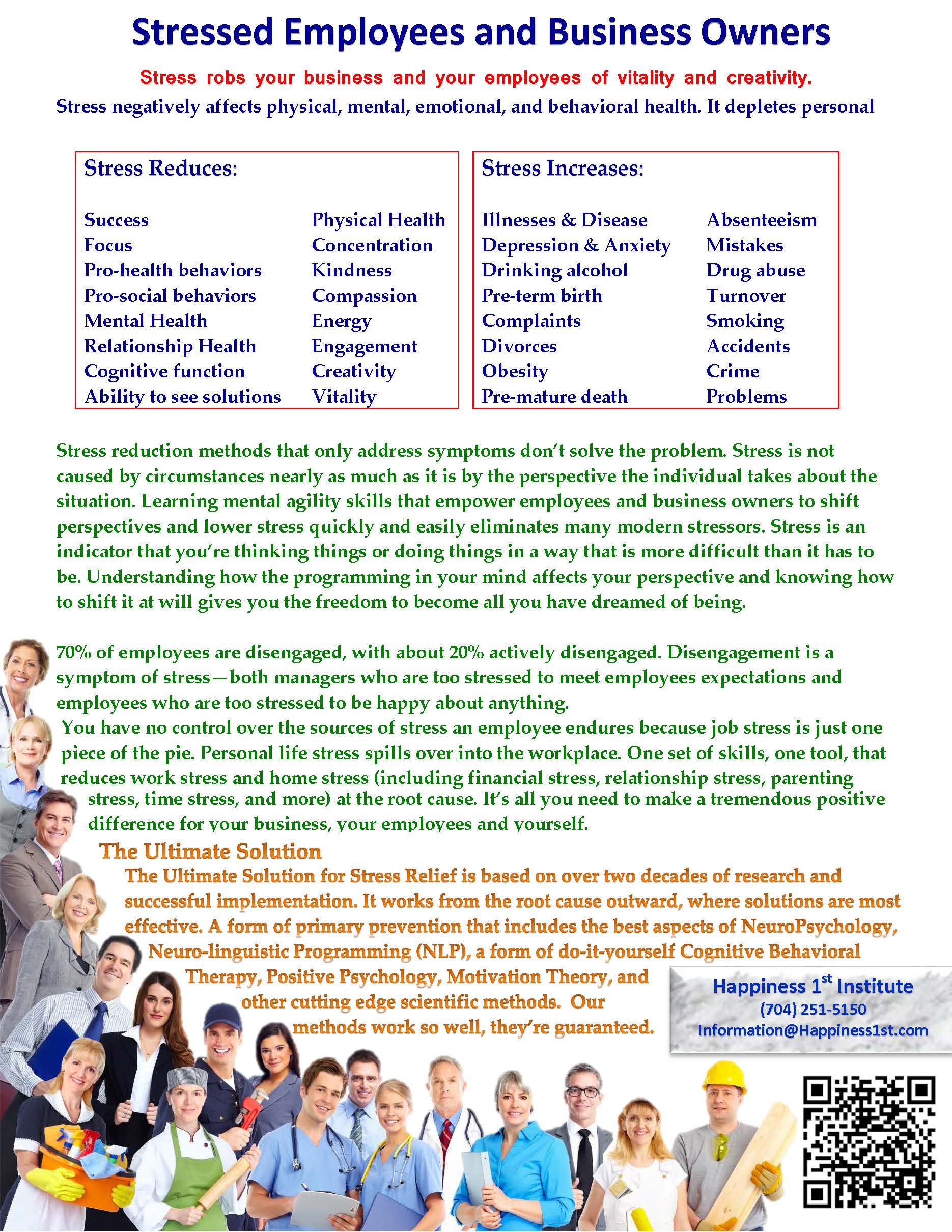 Stressed employees and business owners
Stressed employees and business owners
Helping Stressed Employees and Business Owners
Most stress reduction techniques taught provide temporary improvements and are dose dependent (you have to repeatedly do them to get the benefit), much like medicines that treat symptoms instead of curing the problem.
Our program teaches skills that create mindsets that are more adaptable and that actually experience less stress than untrained minds in the same circumstances.
The changes become permanent and life is less stressful thereafter.
Lower stress means more engaged and productive employees. This is a competitive edge that keeps increasing.
Because we address stress relief from the root cause, the benefits spread throughout the system (physical, mental, behavioral).
Students and Stress
Students and Stress–most of the stress is optional if you have the skills.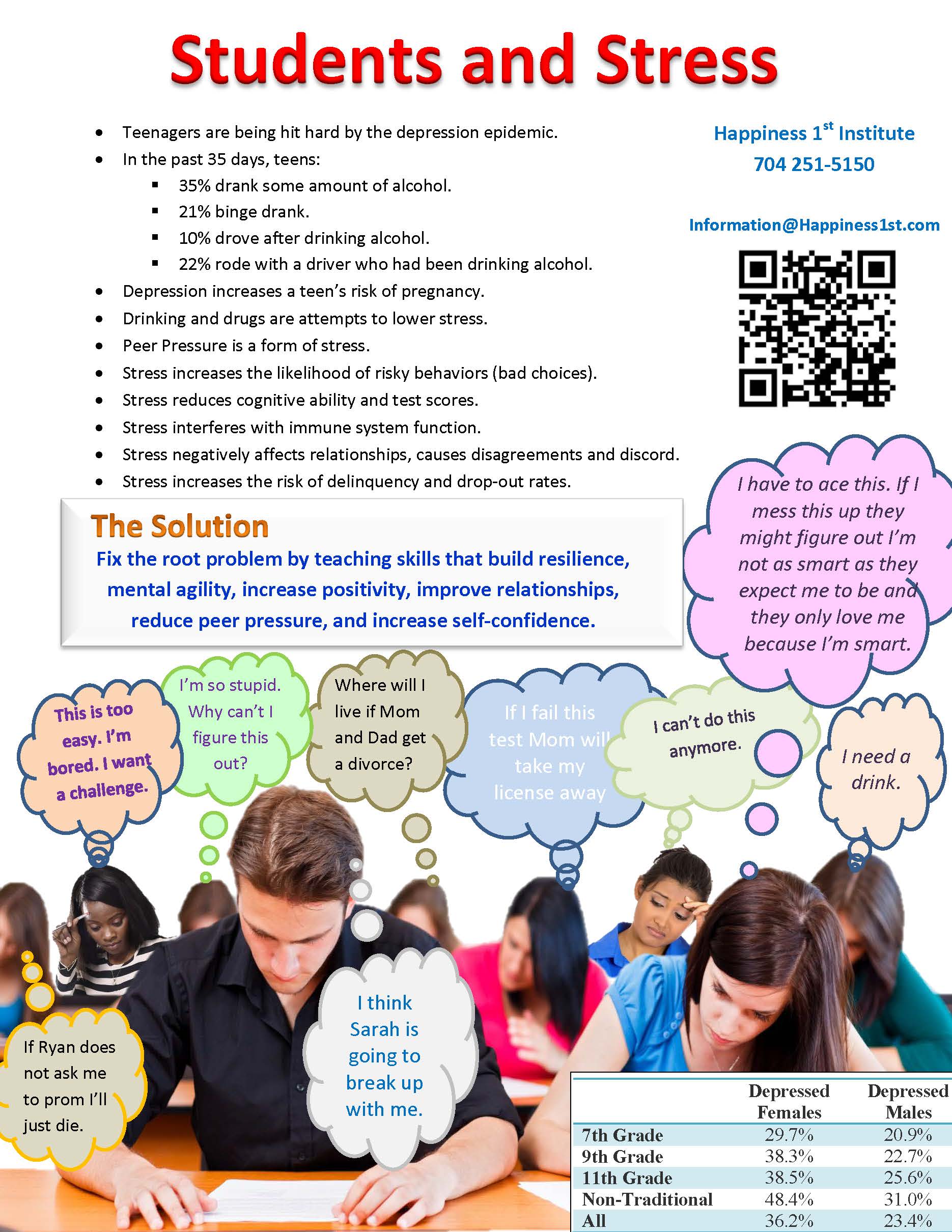
Stressed Students at desk flyer
Interested in learning more? Sign-up for one of our FREE, no risk, no pressure introductory evenings where we give you helpful information that can help you and information about programs that can help you change your life to what you want it to be in every area.
https://www.happiness1st.com/events/introductory-evening/
Empower Yourself
Your mindset is really programming, specifically it is how your brain is programmed. We all have programming and most of it was created by default, by our experiences, upbringing, thoughts, examples, and conclusions. All these things shaped our mindset.
Default programming is not optimal programming.
Realizing that your programming may be hindering your success in all areas of life and that you can change your programming are the two most empowering things most people can learn.
Understanding this is the 1st step to changing your mindset.
Your mindset creates filters that determine which of the millions of bits of information your senses pick up are made available to the conscious mind. The unconscious mind processes millions of times the information the conscious mind is ever aware of. When you change your mindset, your filters change and the world literally changes–not because anything actually changed other than your perception.
You can’t live a great life with sub par programming.
Empower Yourself
If you’re ready to improve your programming, contact us. We have the best techniques and can help you understand how changes will change your outlook so you can decide for yourself what programming you want in your head.
Jeanine Joy is an inspiring and life-changing author, speaker, and scholar. The purpose of her life is to seek out knowledge that increases human thriving, create explanations and processes that provide practical ways for individuals adopt strategies that enhance their lives. Her programs, books, and speeches empower people to fulfill their dreams and enjoy more loving, happy, and successful lives. Her ultimate goal is to help create a better world for everyone.
[contact-form-7 id=”702″ title=”Basic contact form with solve”]
Call for Peace
Call for Peace (Re-printed from a post originally posted on House of Peace and Love for All)
Learning about senseless tragedies saddens me deeply because there is a better way and because the pain that a senseless tragedy leaves behind creates ripples that can lead to more pain.
I am saddened by the recent loss of life in Charleston and saddened by the suffering of the families and saddened that we still live in a world where the connection between emotional state and behavior is not understood enough that someone who is angry is helped to find a better emotional state.
Anger that persists is a form of mental illness. It may not be a diagnosis code in the DSM, but it is a form of mental illness, or perhaps more accurately, a lack of skill in dealing with emotions.
Happy people aren’t killing anyone.
People who are unhappy and trying to find a way to feel more empowered kill people. Unhappiness can range from jealous all the way down to anger, rage, and depression.
Behavior is entwined with emotional state; it cannot be separated.
Emotions are indicators that we should take action. Joy is an indicator to continue doing what we’re doing with the way we’re perceiving our current circumstances.
Anger is an indicator that we’re harming our self if we continue perceiving our current circumstances in the way we are currently perceiving them.
Anger does not validate the rightness of your stance.
Anger merely tells you that your current thoughts do not support your long-term goals.
Your anger may feel justified. It may even be justified according to large numbers of other people. It is still hurting you.
Anger is better than depression, but it is not a good home. It is not even a good place to visit frequently.
It is not an emotion to allow yourself to steep in because doing so clouds your thought processes and frequently leads to actions that create more anger.
Anger comes from a dis-empowered perspective.
The best response to anger is finding a more empowered perspective from which to view the situation.
I was saddened to learn that the shooter in Charleston hoped to begin a race war in America. I am gladdened to see the response.
I heard Malcolm Graham speak on the news about the loss of his sister, Cynthia Hurd, saying that we need to learn to live together peacefully and my heart soared. To hear someone with a loss so close to his heart calling for peace tells me that we are closer than I thought.
Why does it make my heart soar? Because peace and harmony are possible. There is a way to live peacefully in the world even before everyone is doing so. In fact, peace can only come one heart at a time.
Politicians and soldiers do not bring true peace.
True peace only happens when individuals’ hearts have peace within them.
Hearts filled with anger and bitterness lead to senseless tragedies decades after peace has been declared by politicians and soldiers.
The path to peace is one of learning the real meaning of emotions. They are guidance from God letting us know how close to the way God sees the situation we are perceiving it. When we’re joyful, we are perceiving the situation the way God perceives it. When we are in love we are perceiving the person the way God perceives the person. When we are frustrated we are perceiving the situation differently from the way God is perceiving it. When we are angry we are even further from God’s perspective of the topic than we were in frustration.
The worse the emotion feels, the more variance there is between our opinion of the situation and God’s opinion of the same situation.
If you feel the Call for Peace:
The first step is to recognize what emotions are.
If you want a religious view on the topic, see the quotes in the Bibliography and if your worldview is not represented, look to the scriptures for your faith and find it there.
If you want a scientific view on the topic, see the publication by Katherine Peil in Global Advances in Health and Medicine, also cited in the Bibliography.
The second step is developing skills that empower us to see more in line with the way God views the world by developing mental agility that helps us take different perspectives.
The third step is to put peace in your heart. The first two steps are necessary first because you must release the resentment, anger, and other strong negative emotions before you can truly feel peaceful toward all others. This seems an impossible task before you understand the link between emotions and behavior and develop the skills that enable you to see the world more as God sees it.
When you understand those things and use them, putting peace in your heart feels like the natural thing to do.
As I said earlier, happy people aren’t killing anyone. People who feel dis-empowered and are trying to regain some of their power are the ones who do those things. What they need is a better way to feel more empowered. The first two steps above are that way.
But society needs to recognize what negative emotion represents and help those who get stuck in negativity take the first two steps. The more the understanding spreads, the easier it will be for even strangers to help someone who is in a low emotional place.
I say easier, because we can already to it.
We can give a smile to someone who needs one. We can offer encouraging words to harried Mom’s while we are waiting in line or grocery shopping. We can hold doors open for others and show that we value their humanity. We can be kind for no reason other than being kind feels good (when it is what we want to do).
Those things can help momentarily. But learning the connection between behavior and emotion, what emotions really are, and how to take different perspectives that allow us to feel better without requiring any circumstances to change in that moment help permanently.
One way to make a horrible situation feel better is to give it a different meaning. It is not my place to decide for any other what meaning to give any situation, especially not for the families, friends and church that lost so much. But I can and do encourage others to take Malcolm Graham’s call for peace to heart and I know that along that path is where the greatest solace and meaning will be found, as well as the best world for the future.
If I can be of help in building peace in your community, please contact me.
My heart goes out to the families of Cynthia Hurd, Susie Jackson, Ethel Lance, Rev. DePayne Middleton-Doctor, The Honorable Rev. Clementa Pinckney, Tywanza Sanders, Rev. Daniel Simmons Sr., Rev. Sharonda Singleton, and Myra Thompson.
This post, written by Jeanine Joy, was re-printed from a post on House of Peace and Love for all. Jeanine Joy is the founding minister of House of Peace and Love for All.
Bibliography
(Al-Qur'an), T. (or of the soul which is secure of its salvation, and free from fear or sorrow.). By this the reader will observe that the Mohammedans are no strangers to Quietism. Others, however, understand the words of the soul, which, having attained the knowledge of the truth, rests satisfied, and relies securely thereon, undisturbed by doubts;
Bhagwath gita. The Lord's mercy is therefore available both in the form of the instructing spiritual masters and the Supersoul within the heart...
Bhagwath gita. The Supersoul within everyone's heart, directly gives us guidance...the spiritual master in the heart, gives direct inspiration.
Proverbs 16:9. A man's heart plans his way, but the Lord directs his steps. Bible.
Proverbs 3:5. Trust in the Lord with all your heart and lean not on your own; In all your ways acknowledge Him, and He will make your paths straight. Bible.
Buddhist teachings. Wisdom is born of meditation deep, But lost by mind's distraction; knowing these Two paths of loss and gain, so let him live, Let him so direct his life that wisdom may increase. 282.
Confucius. By three methods we may learn wisdom: first, by reflection, which is noblest; second, by imitation, which is easiest; and third, by experience, which is the most bitter.
Peil, K. T. (2014). Emotion: The Self-regulatory Sense. Global Advances in Health and Medicine, 80-108.
[contact-form-7 id="702" title="Basic contact form with solve"]
Stress Culture to Health Culture
Since the 1970’s, it has been widely recognized that stress is bad for our health. Researchers agree that at least 60% of illnesses and disease are the result of stress.
During the years since the 1970’s we have learned many details about the path stress takes and how it harms our physical, mental, emotional, and behavioral health. Those pathways are helpful in creating pharmaceutical bandaids (which I know are needed by many people today). But, the reason they are needed is because the recommendations for dealing with stress have not changed or advanced much in the last 40 years. Oh meditation and yoga have moved out of the cult or woo woo classifications they once suffered and become more mainstream, but the root of stress is still not being widely addressed.
As Thoreau said,
There are a thousand hacking at the branches of evil to one who is striking at the root.
If you substitute stress for evil, I would say,
There are a thousand hacking at the branches of stress to one who is striking at the root.
Happiness 1st Institute exists because I came to understand the root cause of stress and how to eliminate it and recognized the significant benefits to society’s around the world that could come from sharing what I had learned. Unlike much of the advice given today, eliminating the root cause of stress does not require anyone to give up activities they enjoy. In fact, doing so is counter to what reduces stress.
Addressing stress at its root is a perfect example of another old saying, one Ben Franklin believed,
An ounce of prevention is worth a pound of cure.
Addressing stress at its root is what we call Primary Prevention. It prevents the illness or disease from developing in the first place. Stress disrupts numerous functions critical to healthy living including immune function, cognitive function, digestive function and some central nervous system functions. It can also lead to adverse epigenetic changes that turn on genes that lead to adverse consequences. Cumulative stress (both pre-pregnancy and during pregnancy) have adverse impacts on duration of the pregnancy (causing pre-term births) and adverse outcomes including increased asthma, sleep and behavioral problems, and depression in the children.
A recent infographic produced by the Robert Wood Johnson Foundation (RWJF) shows many of the adverse consequences of stress (although their solutions are not Primary Prevention–they address the symptoms of stress instead of the root).
The negative impact of stress on the body begins immediately. If you’re one of the people who doubt this, recall a time when you were nervous. Perhaps that good looking person you’d been hoping to talk to unexpectedly stepped into the elevator with you at the last moment. If that doesn’t do it, imagine you’re 11 years old when it happens. You remember the instantaneous perspiration, the sweaty palms, perhaps the blush that swept across your cheeks. How long did it take to have that reaction in your body? That was stress. Those are signs of stress you can feel immediately. What you don’t feel is the slowing down of your immune function and digestive function or the cognitive constriction of your ability to think clearly (or maybe you did feel that if that person stepping into the elevator made you tongue tied).
The negative effects begin immediately.
Stress Culture to Health Culture
Our bodies are designed to respond to stress and return to a relaxed state but our society’s beliefs and structure do not support that. We are trained to remain in hypervigilant states of worry, fear, and concern. We are trained to live with stressors like frustration, anger, grief, depression, hopelessness, irritability and more rather than deal with the negative emotions as they arise. Many people suppress their emotions. Others have felt them so long it has become their norm and they don’t realize that it is killing them–literally.
To truly move from a culture of stress to one of greater health and wellbeing for everyone we must begin using primary prevention to reduce stress. If we don’t, the epidemic chronic illnesses like Type II diabetes, heart disease, addictions, obesity and numerous social problems like crime will all continue to increase. Stress is the root cause and primary prevention is the only way to avoid the undesired outcomes. It is a significant factor in disparate outcomes, one that can be solved today.
We are designed to deal with stress when we experience the negative emotion. When we do, we thrive. When we don’t, we suffer. So do our relationships, our careers, and our level of happiness. New research has pointed the way to do this without having to give up what we love (or even family members we find difficult to love). We can have far greater control over our stress level than most have ever experienced. That’s what we teach at Happiness 1st Institute. If you’re interested in learning more, please contact us for details on upcoming classes.
Believe in Yourself
Our Gifts
Everyone has gifts they have the potential to give the world, their community and their family. Too often these gifts remain hidden because we do not believe in our ability or our potential.
If you ever discourage a dream–your own or someone else’s–ask yourself what gifts your discouragement may be holding back from the world.
Humans have an amazing capacity to rise to the occasion when given the chance. Without hope of success, we don’t give ourselves the chance.
If this post can inspire even one person to at least try to follow one of their dreams, it has succeeded.
We barely know what hidden depths lie in ourselves. So often people are surprised by what they are capable of given the opportunity (or sometimes, the challenge). How can we possibly know what another could do?
Believe in Yourself
Christopher Maloney did not believe in himself for years. He filled out the application to be on X-factor five times and then tore it up because he did not have enough faith in himself to be on the show. Others discouraged him and told him he was not good enough. Finally, after moving in with his Nan to take care of her, her faith convinced him to try. Here is the result:
One of my teachers once said something that I think is totally appropriate to say to everyone, “What right do you have to deprive the world of your gifts?”
Magic happens when you believe in yourself.
What would it take for you to believe in your dreams? Whatever that is–Do it. Trust yourself.
[l2g name=”” id=”1620″]
Pessimists Don’t Die Peacefully In their Sleep
Researchers have begun looking at how mindset affects health. Their findings are telling.
Optimists live an average of 10.7 years longer but they enjoy 18 healthier years because the debilitating end of life diseases visit them much closer to the end than they do pessimists.
Illness likes to visit pessimists and illness likes to stay longer when it visits pessimists.
Science can tell us why this is true. Our immune system works best when we feel positive emotions. The decline in our immune function is instantaneous when we feel negative emotions. Decreased immune function equals increased illness and in later life, increased chronic illness.
Digestive function also suffers when negative emotions are felt. Sometimes it is an immediate response when someone throws up upon seeing a distressing sight. The lucky ones among us only have the experience of watching others do this in movies or reading about it in books. Others have first hand experience. More of us have experience with the stomach feeling upset almost immediately after hearing distressing news. Long-term negative emotion (often referred to as stress) leads to long-term digestive problems including a greatly increased risk of diabetes and of obesity.
Cognitive function also worsens with stress and the choices we make about things like foods, smoking, drugs, and alcohol are worse when our emotional state is worse.
Pessimists tend to develop chronic illnesses about 7 – 8 years before death, on average. Some do it far sooner and a few don’t suffer as long. When compared to optimists whose average pre-death illness is no more than two years, pessimists have it rough.
Pessimism effectively creates a self-fulfilling prophesy.
Most people think being pessimistic or optimistic is an innate trait. The truth is that both are simply habits of thought. Like all habits, they can be changed to healthier habits. Leaving pessimistic tendencies behind does not discard the essence of who you are–it allows the beauty of you to shine through in new ways. It also feels good.
We are experts in helping people who have decided they want to change their habits of thought successfully do so. Ask us how we can help you today.
Resilience and Mental Health for Nepal
 Resilience and Mental Health for Nepal
Resilience and Mental Health for Nepal
Nick Stockton wrote an excellent article highlighting the importance of addressing mental health issues after a diaster, Let’s Stop Nepal’s Mental Health Crisis Before It Happens. Prevention before something happens is Primary Prevention and if you’ve been following my blogs or attending my classes, you know that is the main focus of everything I do.
An ounce of prevention is worth a pound of cure.
This old adage is true with health. We do it routinely in many areas of life but its potential to improve life is overlooked in many areas. Hand washing is a form of Primary Prevention. So is adequate sleep, good nutrition, and an optimistic outlook.
In his article, Nick quoted Richard Mollica, director of the Harvard Center for Refugee Trauma. He has been “a pioneer in bringing attention to the mental care of people who have lived through mass violence, civil war, torture, and natural disasters.”
“Mentally traumatized people have shorter, more sickly lives, You may not die at first, but you will die 20 years after a catastrophe from diabetes and stroke.”
He’s right. Stress Kills–literally. Without relief the increased stress from the earthquakes will result in immune and digestive systems with significantly impaired function. The increased stress will cause more pre-term births of infants whose chance of a healthy life (or even survival) is lower than it could be.
There is a way to empower people to take perspectives that support mental health. Some mental health professionals have described it as a form of DIY (do-it-yourself) CBT (Cognitive Behavior Therapy). The reason this would be such a beneficial approach in Nepal and other disaster areas is that large groups can be taught the techniques simultaneously because the individual applies the techniques to them self (there is no need to spend hours or days of one-on-one time trying to explain how you’re feeling to someone else. The individual is taught to recognize the difference between more and less mentally healthy habits of thoughts and consciously choose the healthier one. The choice is easy because it literally feels better than not making it. The only form of health focused self-improvement that does not require pain for gain. It’s been successfully used to reduce even long-term ingrained PTSD.
The long-term negative effects can be minimized. Our programs teach these skills. If funding is provided, we are willing to go to Nepal and do all we can to avoid another tragedy for this quiet country.
Employee Respect: Who Gets It?
The approach the solution to employee engagement has been taking is misguided. Ask yourself why engagement numbers are down to 30% levels according to recent Gallup surveys. Harvard Business Review (HBR) recently surveyed 20,000 employees worldwide and half of them feel disrespected by their bosses.
If you’ve ever watched Criminal Minds or countless other shows, you know that it is not the intent of the communicator but the reception/perception of the receiver that determines the message that is communicated. Someone who feels disrespected frequently (by teachers, family, friends, society) will not feel respected because the boss is careful about how he or she communicates. Often, these individuals do not respect themselves so they certainly don’t expect others to respect them. They want it–absolutely they want it. They want someone to come along and give them respect and magically make them feel better. They don’t know that they can’t feel respect until they respect and like themselves. They allow a negative string of self-doubt to tarnish their existence.
Until they respect themselves they can’t feel the respect others show them. Ask anyone you know who has made amazing progress in their life what made the difference for them. They will tell you that it was when they changed their perception about them self. People treat us as we expect to be treated. We give off clues and when we do not respect ourselves we might as well have a neon sign floating above our heads letting others know. It is obvious to anyone who does respect them self. It’s obvious because they know what they are willing to tolerate and what they are not willing to tolerate.
I had my own journey where I went from not feeling worthy and not thinking I was good enough. When I changed my own view of myself, the way everyone else treated me changed. I mean everyone. From bosses/employers, to significant others, my children, my parents, and even the clerk at the grocery store. It felt magical. When I changed me, the non-verbal clues I sent that others read (often unconsciously) changed.
Few people in our society truly feel worthy of self-respect. They have negative voices in their heads constantly criticizing themselves. Or maybe, like me, they were taught they had to earn respect but never given a way to calculate when that task was complete. If you have to “earn it” how do you know when you’ve done accomplished it? I had long since earned a lot of things before I began believing I had earned them. When I changed my belief from “I have to work hard and prove myself before I can have that (respect, executive promotion, six-figure salary, nice house, etc.) to I have earned this and I deserve this, it all came. In the space of two years my entire life changed and all those things I had been striving to prove myself worthy of came quickly and easily.
I’m not special. I’ve seen other people change their beliefs about their self and their life changes, too. I help people make this transition and I see the changes they experience as a result. No, I am not special, but I am worthy. Everyone else is worthy too, but so many just don’t know it.
You have to believe you deserve respect. So many don’t. I wish everyone could learn to respect themselves. You have friends who don’t, maybe you don’t either.
You know the friend, the one who is amazing and inspires you,yet when you compliment they wave your accolades aside as if their accomplishments are nothing or flawed. I’m not talking modesty here. You know him or her. The one who truly does not believe they are worthy of the praise you’ve giving them. That businesses continue attempting to make this about the manager and about changing the manager baffles me. It is the employee who needs to learn they are valuable and worthy of respect so they can actually receive it. Until they do, they have an energetic wall up that blocks them from perceiving the respect they are shown.
Helping employees value and respect themselves will enable them to receive the respect their boss feels toward them. It will also make the bosses respect more authentic because how you treat yourself is usually reflected in how others treat you.
It is possible to decide how you will treat others and treat them that well regardless of how they feel toward themselves but that takes a lot of work and few people consciously make that choice. I saw a video earlier today that reflects how few consciously make that choice. First, a disclaimer, I do not believe that clothes make the person, but in many cases the person who does not respect themselves does not dress well–it is an indicator of how the person perceives him or herself. It’s not always true–sometimes people dress especially well to cover up insecure feelings–but it is true often enough that many people will make assumptions about a person based on their attire. And sometimes, the very secure will dress for comfort because they are not seeking approval from others. Now, for the video:
It’s clear in the literature across the ages, from the greatest thinkers of all time to scientific literature being produced in the best Universities of the 21st Century. You have to respect yourself first.
Working on management has limited returns for employee engagement because it treats a symptom, not the root cause of the problem.
Give employees the knowledge and skills they need to increase their self-respect.
[contact-form-7 id=”702″ title=”Basic contact form with solve”]
Smart Employers Know . . .
Smart Employers Know the effect of chronic stress on the success of their employees and therefore, their business.
The smartest employers are implementing programs that teach employees psychological flexibility that considers the human drive for autonomy and reduces stress far more than any of the dose dependent stress reduction methods.¹ ²
Smart Employers Know that focusing their efforts on Primary Prevention which is designed to prevent problems from occurring, rather than waiting until after they occur to address them, will always be ahead of those whose strategy is reactive.
Smart Employers Know that the level of stress most employees experience in modern society is typically enough to be in the harmful level. Our society routinely tolerates far higher levels of stress than is healthy, often wearing the level of stress tolerated as a badge of honor. This tactic is completely ignorant of the facts that living with chronic stress:
- Decreases the function of our immune system, leading to more illness and earlier deaths
- Decreases cognitive function, leading to more unhealthy decisions and a lower ability to solve problems
- Contributes significantly to the high percentage of GNP we spend on health care while receiving poor results
- Increases the chance of addictions
- Is the leading contributor to mental health issues from depression, anxiety to bipolar disorder and more
- Increases the prevalence of chronic diseases that rob people of a high quality of life far too often and at young ages
- Significantly reduces the quality of relationships of all types, from spouses and children to co-workers and neighbors
- Is the # 1 factor that prevents good results in:
- Employee Engagement
- Turnover
- Absenteeism
- Creativity
- The impact of stress begin almost instantaneously and compounds over time
- The risk of preterm delivery of our offspring when we’ve endured chronic stress for years
- The negative impact on physical, mental, and behavioral health of our children
Smart Employers Know that employees who have been trained in psychological flexibility experience significantly lower harmful stress under situations that produce harmful levels of stress in those who do not deliberately use their ability to be psychologically flexible to reduce stress.
What could your team do that it is not doing now?
Contact us today to learn how we can help your team develop winning mindsets and the psychological flexibility it takes to go the distance and arrive healthy.
(704) 25 one -51 five zero
¹ Kashdan, Todd B., Psychological Flexibility as a Fundamental Aspect of Health, Clin Psychol Rev. 2010 November 1; 30(7): 865–878., doi: 10.1016/j.cpr.2010.03.001,
² Gorin, Amy. A., Powers, Theodore A., Koestner, Richard, Wing, Rena R., Raynor, Hollie, Autonomy Support, Self-Regulation, and Weight Loss, Health Psychology, 2014, Vol. 33, No. 4, 332–339, http://dx.doi.org/10.1037/a0032586
[contact-form-7 id=”702″ title=”Basic contact form with solve”]
Graduate Summer Reading
Summer Reading!? I graduated. I don’t have to do any summer reading.
If you’re thinking that, you’re on the path to failure.
There is more new information every day than any one person can keep up with. You don’t have to know it all, but if you don’t make an effort to keep up with information in areas that interest you, you’re living in the slow lane.
So choose a career that excites you because that will make keeping up pleasurable. That is one of the big keys to success.
Beyond keeping up in your chosen field, creating a winning mindset is even more important to your success in life…in your relationships, in your career, and in your choices. That is what I encourage new graduates to read The Magic of Thinking Big. 
Yes, it’s an old book but it is timeless if you add zeros to the “big” salaries. The advice is sound and for almost everyone raised in the typical educational institution, it will change the way you think in positive ways. In school you were asked to conform but nonconformist thinking is the thinking that solves problems. Conformists are still looking at problems and believing they are roadblocks when successful thinkers are seeing the opportunities inherent within the solutions.
Pick up a copy and start your summer reading today. It may be the most valuable $10. you ever spend.
Oh, and don’t forget to have fun this summer. It’s important.
Best wishes for a future that is more than you dream of it being.
Aging is Optional
For years I’ve said, “Aging is optional.”
I said it before I read the research that demonstrates that our beliefs about aging impact how we age.
Understanding that my personal beliefs about aging affect how I age, I have deliberately looked for examples of what is possible. They’re easy to find when you expect them. I don’t have to look any further than the people in my life to find incredible examples of individuals living well long after most people would expect them to be weak, sickly, and physically compromised.
I came across this beautiful example of an 86-year old lady gymnast today and wanted to share it.
As you expand your belief about how well you can do in your 70’s and beyond, you set yourself up for a better experience. Research shows that how we think we’ll do at certain ages has a tremendous impact on how we actually do at those ages.
Essentially, your beliefs about aging are self-fulfilling prophesies. There is a placebo (or nocebo) effect from your beliefs about aging.
If you dread old age, if you see it as a negative time of life you are setting yourself up for a harder time than you have to have. One of the things we can do at Happiness 1st Institute is help you develop beliefs about aging that allow you not to take the unwanted options.
Who do you know that inspires you to enjoy life longer?
Are your current beliefs about aging serving you?
Mental Illness – Will the Stigma Ever Go Away?
Guest Post: I decided to post Dr. Lynn K. Jones’ blog because it is the best summary I’ve ever read on this topic. I believe the key to eliminating the stigma is education and knowledge. When society realizes the cost of stigma they will be willing to let it go. (Reprinted with permission.) Link to her website is here. – JJ
The Stigma of Mental Illness – Will it Ever Go Away?
“Psycho.” “Loco.” “Insane.” These are the words that we all grew up with to describe someone that was—well, perhaps, a little off. Not only that. When we talked about one of these people, we said it with contempt: “He’s totally crazy!”
Tom Wootton heard playground taunts in his head when he was diagnosed with Bipolar Disorder at the age of 45. He flashed on a memory of everyone jeering at one of his classmates. “I thought: If I am bipolar, then I must be crazy. I just couldn’t accept that for a long time.”
Wootton is not alone. “This self-stigmatization, the internalizing of stigma, is one of the most significant barriers keeping people from accessing mental health treatment,” suggests Patrick W. Corrigan, Psy.D., professor, Institute of Psychology, Illinois Institute of Technology, principal investigator of the Chicago Consortium for Stigma Research and executive director of the Joint Research Programs in Psychiatric Rehabilitation. Fifty-four million Americans, nearly one in five, have a mental health disorder and nearly two-thirds of them won’t seek treatment1 because of stigma. That means that the playground stereotypes that affect our attitudes have consequences. Often fatal consequences.
“An indication of how strongly held these beliefs are, is that many people would rather tell employers that they committed a petty crime and served time in jail than admit to being in a psychiatric hospital,” according to Amy Watson, MSW, PhD, previously the program director of the Chicago Consortium for Stigma Research and presently assistant professor at the Jane Addams College of Social Work at the University of Illinois at Chicago.
What is Stigma?
“Stigma involves setting apart a group in society and associating particular characteristics with them, which we think of as stereotypes,” says Beth Angell, MSW, Ph.D., assistant professor of the School of Social Service Administration at the University of Chicago. “In the mind of the public, having a mental illness seems to be associated with some undesirable attribute, for example the belief that people with mental illness are more violent than others or that they lack the competence to be able to negotiate social roles, such as working.
“It is difficult to know exactly how those stereotypes come about; they can be caused by lots of factors. For many years people with mental illness were sequestered in institutions and hidden from society, having minimal contact with the public. During the 1950’s – 1960’s we slowly began a process where we deinstitutionalized people with mental illness and they began living in the community. As a result of that, a much more visible group of people with mental illness who needed help contributed to the public developing negative stereotypes about mental illness, such as violence or bizarre behavior.”
Not In My Backyard
The Santa Barbara, California woman who recently went on a killing spree is the type of image we often have fixed in our minds about people with mental illness. These images don’t just come from the nightly news; they also come from popular dramas on TV. The cameo that opens Law and Order, for example, is often a scene of a violence committed by a person with mental illness.
“We know that people with mental illness are statistically no more likely to be violent than persons without mental illness,” says Jack K. Martin, Ph.D., executive director of the Karl F. Schuessler Institute for Social Research and professor of Sociology at the University of Indiana. “Unfortunately, the overwhelming perception about people with mental illness is that they are very likely to become violent.”
Martin recently completed, along with his colleagues at the Indiana Consortium for Mental Health Services Research, the second of four studies on the impact stigma has on people with mental health problems.
The first study, completed in 1996, evaluated whether American’s attitudes about mental illness had changed, since they were last studied in 1950. “What we found was encouraging and discouraging at the same time,” says Martin. “People used to see the cause of the problem as something about the individual’s character. It used to be that people would say: ‘This was God’s will.’ ‘These are bad people.’ ‘This was their punishment.’ They don’t say that anymore. People now have an ability to explain mental illness accurately, defining it as a chemical imbalance or a genetic predisposition to mental illness, often triggered by stress; they have basically adapted a medical model. A real common point of view used to be that mental health problems weren’t treatable; people no longer believe that.
“At the same time, people unquestionably have high levels of willingness to shun people with mental illness and in particular, they don’t want to work with them and they don’t want someone who is mentally ill to join their family by marriage. So while they have more clarity about where mental illness comes from, they really want to avoid any contact.”
Stigma Sticks
Why are the stigmas associated with mental illness so sticky–especially when people are more educated about mental illness? More understanding should lead to acceptance, but “in fact there is evidence that people know much more about mental illness and that the stigma seems to be worse,” says Corrigan.
“Our work suggests that the biggest factor changing stigma is contact between people with mental illness and the rest of the population,” says Corrigan. He is trying to understand how to get consumers to go public with their mental health problems. The public needs to understand that many people with mental illness are functioning, fully contributing members of society. To better understand how to do this, Corrigan has studied the gay movement, since they have been so successful in coming out. “Just as the gay community had to realize that their power was increased as they came out of the closet, a similar realization needs to occur with people with mental illness. They are reluctant to do it, for understandable reasons, but nonetheless that is what needs to happen.”
Wootton is someone who has come out. He has written a book about his experience living with Bipolar Disorder, The Bipolar Advantage, is the president of his local Bipolar Disorder support group, has established a workshop program for people diagnosed with Bipolar Disorder and talks to groups several times a week about his mental health issues—both the pain and the progress. He says that other people with Bipolar Disorder appreciate what he is doing—so that they don’t have to do it. They feel too vulnerable. They fear the stigma.
The National Alliance of Mental Illness (NAMI) realizes what an impediment stigma is to people in mental health treatment and have launched a “StigmaBusters” campaign. One initiative is to get people with mental illness to speak out and they have provided the support and structure through their In Our Own Voice program. (See Sidebar.)
Just Like Anyone Else
Most people with mental health problems would not wish them on anyone. But more and more we are beginning to recognize that people with mental health problems don’t just have problems—they also have talents that make real contributions to society. Just like anyone else.
Wootton views his Bipolar Disorder as an “advantage.” Before his diagnosis he was a successful software programmer and earned millions by working feverishly at a highly creative pitch—for months on end–thanks to his uncontained Bipolar Disorder. Of course, he couldn’t sustain this and eventually hit a bipolar wall. Now he strikes a balance between controlling his bipolar disorder while still benefiting from his creative talents. This is a result of a combination of medication, therapy groups and what he describes as “ a lot of hard work.” He also works with his doctors to calibrate his medication so that he is still able to tap into his Bipolar capabilities. This means that he is somewhat outside what they consider his ideal range of functioning, but still within acceptable limits for him.
Or think of Monk, the endearing TV detective who is able to discern things beyond the reach of others on his police unit. He makes no bones about the fact that his compulsive cleanliness can be a hindrance, but the good outweighs the bad. He too, works on his issues in therapy, but he rejects medication. With medication he feels good, but he loses his special talents.
John Nash, portrayed in The Beautiful Mind, won the Nobel Prize for the work he did in the field of mathematics all the while struggling with the delusions and paranoia of schizophrenia. He learns to live with and control his delusional friends, which releases the power of his intellect to change the world.
Examples like these are introducing the public to a broader view of the attributes of mental illness; a view that people with mental illness may bring gifts—not just problems. Wootton adds that the message for treatment providers is that recovery is not overcoming mental illness, but harnessing it to preserve positive attributes.
Watson cautions that people with mental illness should be valued for who they are, including those that make everyday contributions like the rest of us. “People with mental illness are mostly like everyone else with similar ranges of intelligence and talents and they should not have to be extraordinary achievers to be appreciated.”
“Many professionals are the bastions of stigma,” says Corrigan. “Part of that might be because they tend to see people only when they are acutely ill. When they are in recovery and acting in a way to challenge a stigma they are not with them.
“People with mental illness can and do recover. It is contrary to what we all learned in graduate school, which is ‘once a schizophrenic always a schizophrenic.’ The long term follow up research suggests that 2/3 of people with intense schizophrenia can live successful lives; perhaps half of them will need job coaches or housing coaches for much of their life, but still people when they receive reasonable accommodation live pretty well with schizophrenia.”
Social Justice Challenge
The social cost of stigma associated with mental illness is high, because it translates into huge numbers of people with treatable mental illness not getting help. In Martin’s research, 45% of people said that if they had a mental illness they would not take medication for it, even though they believe that the medication would work. They are not worried about side effects. “They are worried that if they do take medication that someone is going to find out and then they will have to suffer the consequences, including the disruptions of marital relationships and work productivity,” says Martin.
Is a society without debilitating mental illness out of reach? It turns out it is not. There is a pilot program in Norway, being led by Thomas McGlashan, director of the Yale Psychiatric Institute that reportedly has been so successful that people with schizophrenia are not living on the streets. The key seems to be eliminating stigma. When stigma is reduced and people feel safe coming out they get treated at the early onset of the illness, which greatly improves their outcomes. The destigmatization campaign includes the education of students, primary care physicians and the general public.
So it is possible. The Norway experience shows us that when stigma is substantially eliminated and a supportive health care system is in place, the rights of people with mental illness are protected. When their rights are protected, people with mental illness can experience the full benefit of the progress that has been made in treatment without constraining their potential to contribute to our society.
Will the stereotypes of “psycho” and “loco” ever totally go away? Probably not. But we can reduce the impact of stigma and bring people to life-restoring treatment. Everyone wins when people with mental illness are not just tolerated but appreciated for who they are and can be full participants in society.
1 Surgeon General’s Report on Mental Health, 1999.
SIDEBAR
Fight Stigma: Become A StigmaBuster!
The National Alliance of Mental Illness (NAMI) StigmaBusters is a group of dedicated advocates across the country and around the world that seek to fight the inaccurate, hurtful representations of mental illness. Whether these images are found in TV, film, print, or other media, StigmBusters speak out and challenge stereotypes in an effort to educate society about the reality of mental illness and the courageous struggles faced by consumers and families every day. The StigmaBusters’ goal is to break down the barriers of ignorance, prejudice, or unfair discrimination by promoting education, understanding, and respect.
Each month, close to 20,000 advocates receive the NAMI StigmaBusters Alert, and it is read by countless others around the world online and in mental health centers, hospitals, universities and elsewhere. NAMI urges everyone to get involved: “Numbers do count, so let your voice be heard.”
By going to www.nami.org you can find out more about NAMI StigmaBusters and how you can report stigma, and sign up to receive NAMI’s StigmaBuster Alerts.
In Our Own Voice: Living with Mental Illness is a recovery, education presentation given by trained consumer presenters for other consumers, family members, friends, professionals, students of all academic levels, and lay audiences.
A brief, yet comprehensive interactive presentation about mental illness – including video, personal testimony, and discussion enriches the audience’s understanding of how people with these serious disorders cope with the reality of their illnesses while recovering and reclaiming productive lives.
In Our Own Voice: Living With Mental Illness was developed to provide a dialogue on the issues related to recovery from severe mental illnesses. The program is designed to provide a safe place for consumers to share the ups and downs of their recovery and learn from others. A trained consumer presenter leads the discussion. The program educates everyone about the ongoing recovery issues we face and the fulfilling lives that can be achieved.
Consumers that have participated in the program say, “We give hope, we educate, we open minds, and we change attitudes. We help eradicate the stigma surrounding mental illness.”
NAMI reports that research studies have shown that the In Our Own Voiceworks and that there is a significant decrease in stigma against mental illness among audience members after seeing the presentation.
Find out more about bringing the In Our Own Voice: Living With Mental Illness program to your community at www.nami.org.
Author: Dr. Lynn K. Jones
Certified Personal and Executive Coach
Dr. Lynn K. Jones is a Certified Personal and Executive Coach based in Santa Barbara, California and a sought after coach and consultant for organizations and individuals across the US. Her doctoral work completed at theWurzweiler School of Social Work, Yeshiva University concernedorganizational culture; she coaches, consults and trains organizations on what they need to do to create organizational cultures that are aligned with their vision and values using a process of Appreciative Inquiry. She coaches individual on achieving their reflected best selves. An MSW@USC faculty member, Dr. Lynn K. Jones, MSW, DSW, CSWM, teaches Human Behavior and Social Environment.
Perfectionism Harms
Perfectionism Harms
People wonder why so many people fail to thrive in modern times. One reason is we have widely accepted but inaccurate beliefs about many things that affect our well-being on a regular basis.
Our classes overturn a few dozen of these false premises. Today I’m writing about perfectionism. It is commonly accepted as a positive characteristic to be admired and developed, perfectionism is often praised.
It is true, there are some benefits that come from pessimistic tendencies. I’m just not sure they are worth the price the individual pays. It varies on an individual basis, and we have to look at the underlying reason the person attempts to achieve perfection to know whether it is harmful on an individual basis. If it is a critical task, for example, brain surgery, perfection is essential to task. The brain surgeon who has perfected her craft but can allow herself to not be perfect in other areas of life, whose perfection is dictated by the necessity for perfectionism, is far less likely to suffer the negative consequences of perfectionism. In fact, I would not describe such a person as a perfectionist.
Another brain surgeon, just as skilled, who also demands perfectionism from his children, spouse, home, attire, and public persona is at risk of the negative consequences of perfectionism. The pervasiveness of the tendencies indicates that the underlying reason for the characteristic is not healthy. This type of pervasive perfectionism causes persistent high stress on the body and mind of the individual.
One of the very common, but not well-known, risk factors for suicide is this sort of perfectionism.
“…high Persistence and Harm Avoidance are predisposing traits for burn-out in healthcare professionals who are often overly perfectionistic and compulsive, predisposing them to anxiety, depression, suicide and burn-out.” (Stoyanov and Cloninger)
The perfectionistic tendencies result in this person hiding their discomfort and angst. Often it is the type of suicide that surprises those closest to the individual. They hide their symptoms and then apply their desire for perfection to their attempt at suicide, which increases the death rate from those attempts.
This same type of perfectionism increases the risk of burnout.
Perfectionism is not a fixed personality trait. It’s not easy to change if you don’t have the key but with the key it is relatively simple to change. Many people simply believe that is how they are–an integral part of their personality–part of what makes them who they are. That is not true. It is a reflection of the fact that these tendencies develop at a young age, not of the immutability of the characteristic.
If you are a perfectionist who demands perfection in all areas of your life, your life is far more stressful than it should be and far more stressful than it has to be. That is a less than perfect life. We can help you relax and enjoy your life more without giving up the quality you demand of yourself in the areas where it is important. Any of our premier programs would help you and those you love enjoy your lives and one another more fully.
Burnout in High Stress Occupations: Solutions
Employee Engagement
Recent studies have reported employee engagement levels at or below 30%. Traditional methods of employee engagement attempt to change the corporate culture and management in order to change the employees. But older wisdom tells us that true change must come from within. After decades of using the traditional approach with dismal results (30% of employees are engaged), isn’t it time to give another method a try? The results could hardly be worse.
Burnout in High Stress Occupations
Worldwide, burnout in high stress occupations is taking a toll and causing concerns. This is especially true in the healthcare industry where physicians and nurses are experiencing burnout with two dire consequences. 1) The care they are able to provide is lower as a result of the burnout, and 2) They are leaving the field and taking their years of training,  expertise and experience with them.This is not good for the employees, the employers, or the public. Burnout and lack of employee engagement go hand in hand.
expertise and experience with them.This is not good for the employees, the employers, or the public. Burnout and lack of employee engagement go hand in hand.
We need a better solution and there is a mountain of evidence pointing to resilience as the missing piece. Resilience stands alone as the most important factor in maintaining employee engagement.
“The failure or loss of resilience in physicians leads to burn-out, which is a major concern in medical centres because of its impact on health care.” (Eley et al, 2013)
If you step back and look at the relationship between employee engagement and resilience, it becomes easy to see why addressing engagement by attempting to change the environment instead of strengthening employees is failing.
Perhaps employers are reluctant to spend their resources strengthening employees who can leave the organization. I can see how easy that objection to strengthening employees could be made. I also see how short sighted it is.
Beyond a certain point, the work and work environment is far more important to employees than compensation. If that weren’t true, many occupations would have to pay a great deal more to get anyone to do the work.
Does management affect culture? Yes, of course. But a resilient employee can thrive under a bad manager because that employee will respond in ways that support his or her own continued engagement. Resilience relies heavily on mindset. With the last really bad boss I had, I developed several mantras that helped me remain engaged with the work and the company even though I had no respect or trust for the boss I had caught lying and deliberately wasting company resources. At the time I worked for one of what I call the “Big Box banks” and in my time there my bosses tended to last 6 – 8 months, then I’d report to the Senior Vice President until a new boss was hired. I loved working directly for the SVP because of the mutual respect we’d developed over the years. The main thing I had to do to remain engaged in my role was remind myself that the bad boss would be gone soon.
Okay, yes, that is over simplification. But the other perspectives I took to feel better all flowed easily once that one was in place. Did I thrive? Yes. In fact, it was while working under that boss that I was promoted to Vice President. I also did not stress about him after hours. If my mind began ruminating about what he had done that was irritating, frustrating or infuriating I would remind myself that he would be gone soon, which enabled me to let it go. Was he gone soon? Yes. In fact, I’ve noticed that most really bad bosses don’t last too long–not just for myself but also with friends and family.
Who suffers most under a bad boss? It is not the most vulnerable. I was a single Mom raising two children on my own. It is the one who believe the current problem is going to be permanent. The ones who worry not just about today, but about what it will be like working for that bad boss in six months or six years. It is those who do not believe they can do anything about the situation.
Interestingly, those same traits are associated with depression. Ruminating, anxiety, and unnecessary worry make someone vulnerable–not their life circumstances.
What Difference Does this Make?
If your employees are not resilient, adverse circumstances can quickly lead to a lack of engagement. You cannot control the circumstances the employee works under. There are too many moving parts. You have some control over these parts but no control over most of them. The employer cannot control whether or not the:
- Employee gets adequate sleep before coming to work
- Employee’s children are cooperative while they prepare for the day ahead
- Employee eats breakfast
- Employee argues with members of their family before coming to work (or even during work)
- The morning commute goes well (millions of moving parts here including other drivers being rude, getting a ticket, having an accident, car breakdowns, spilling coffee, heavy traffic, noticing weeds allowed to flourish in a neighbor’s yard, a song on the radio that makes the employee feel sad, flat tires, parking issues, and more)
- Other employees are rude to the employee
- Customers are rude to the employee
- Employee likes the way coffee in the breakroom was prepared
- Employee has minor illnesses or aches/pains (i.e. tension headaches, minor stomach upset, indigestion, sore muscles, etc.)
- Employee is worried about personal finances
- Employee is worried about a child being bullied, skipping school, having sex, drinking, doing drugs, smoking or other undesired activities
- Employee is worried about the health of a personal relationship
- Employee is worried about a loved one for an unlimited number of reasons
- Employee feels loved or appreciated by anyone
- Employee finds meaning in their work (this is a function of perception–not the role)
The above list may seem lengthy but it is far from an exhaustive list of factors that contribute to the employee’s performance on any given day. If the employee works with others, whether bosses, peers, or subordinates each factor would be multiplied by each of the people with whom the employee has interactions.
The bottom line is that the employer cannot control the work environment beyond a very limited scope. How the employee responds to the circumstances has a far greater impact on employee engagement than anything the employer can do. Resilient employees respond to life’s ups and downs in ways that allow them to bounce back. What is a deep valley to an employee who lacks resilience is a mere pothole to the resilient employee.
The Good news is
Resilience is a learnable skill. (Cloninger & Cloninger, 2011)
Resilience leads to desirable traits including:
- Being responsible
- Perseverance
- Psychological and Behavioral maturity
- Cooperation
- Optimism
- Self-direction
Resilience is associated with a lack of unnecessary worry, anxiety, and negative rumination.
Building A Resilient Culture
You can build a resilient culture that will support and encourage engagement by teaching employees skills that increase their personal resilience. Once taught, there will be a natural tendency to support and strengthen that culture.
We all know, intuitively, that we want to feel good. Resilience feels better than the alternative. Working with other people who are resilient creates an atmosphere that is positive and nurturing. There is less competitiveness within the organization and more cooperation toward accomplishing shared goals. There is a greater desire to better oneself because the belief that doing so will have a positive outcome increases in the resilient individual. There is greater focus on solutions and less frustration with problems.
One of my all time favorite quotes is:
“Give a man a fish and you feed him for a day; teach a man to fish and you feed him for a lifetime.” Maimonides
Teaching employees the skills that lead to resilience is like teaching them to fish. Once acquired the skills are used because using them feels better than not using them. In an organization where all employees are being taught the skills the opportunities for positive reinforcement will help them quickly develop new habits of behavior and thought. The way these skills are taught makes individuals more receptive to feedback about course adjustments than they were before.
If you’re not satisfied with your employee engagement numbers or you’re concerned about burnout, contact us today for a free consultation. You’ll be glad you did.
(7O4) 25I…5I5O
P.S. The other great benefit with our program? The way we increase resilience also increases Emotional Intelligence (EQ), an essential trait of leaders who can go the distance.


